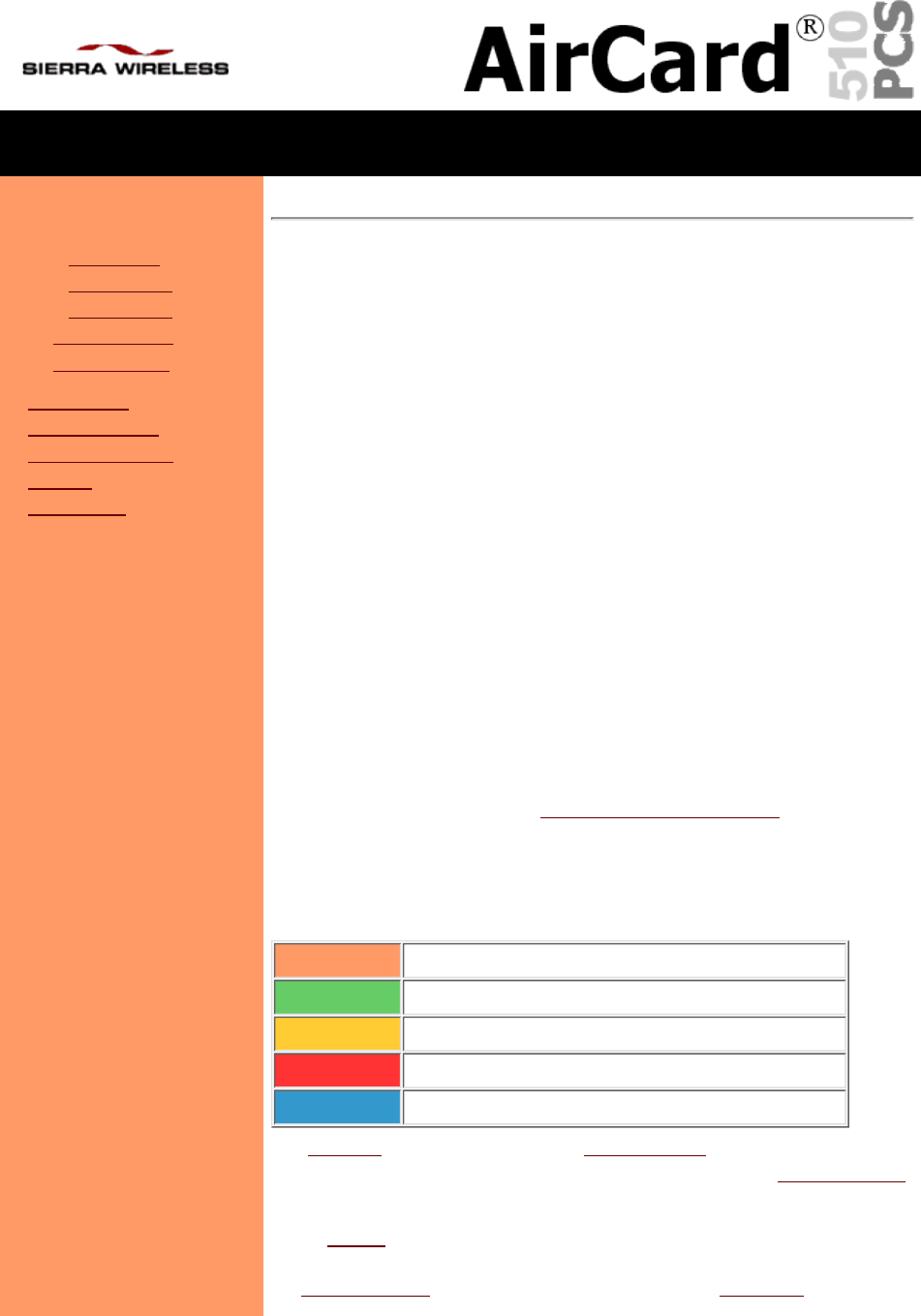Sierra Wireless ACRD510 CDMA wireless modem User Manual AirCard 510 PCS User Guide
Sierra Wireless Inc. CDMA wireless modem AirCard 510 PCS User Guide
Contents
- 1. user manual
- 2. User Manual
user manual

User Guide for Notebooks
o Welcome
o Overview
o Navigating
o Components
o System Req.
o Safety Notices
o Specifications
o Installation
o Using AirCard
o Troubleshooting
o Service
o Contact Us
2110271 Rev. 1
April 2000
Welcome to the AirCard® 510 PCS Modem
The AirCard 510 PCS modem is the first wireless CDMA (Code Division
Multiple Access) modem . It works in any laptop or handheld computer
running Windows 95, 98, NT, 2000, or CE that has a Type II PC card slot.
This modem offers high speed data transmission (14.4 Kbps) and all the
benefits of CDMA technology, including:
coverage that is wide-spread and growing. CDMA currently
encompasses most of North America, Asia, and Australia and is
spreading throughout other parts of the world.
●
continuous power control on the CDMA network means longer battery
life for your laptop.
●
CDMA uses "soft handoffs" between cells in the cellular network,
providing a robust air link and reliable service.
●
CDMA transmission is, by nature, extremely secure. Individual
transmissions are indiscernable to anyone tapping into a radio
frequency channel.
●
Document Navigation
This guide is designed to provide quick access to any subject. It is intended
for those using the AirCard in notebook computers running Windows 95, 98,
NT, or 2000. There is a separate User Guide for Windows CE for those using
handheld computers with the Windows CE operating system.
Some material in this guide is applicable only to specific operating systems.
So that you can readily identify what material applies to your system, the
following colour scheme is used:
Peach General Information for All Systems
Green Green - Windows 95/98
Yellow Yellow - Windows NT
Red Red - Windows 2000
Blue Blue - Windows CE
The Contents in the left margin at the top of the page allow you to jump to
any section and then on to any of its sub-sections. A one step Document Map
is also available to help you navigate.
At the bottom of every page is a navigation option to step forward and
backward through the pages of the user guide, as well as providing access to
the Document Map. The AirCard 510 PCS logo in the top corner of each page

will also take you to the Document Map.
Your AirCard 510 PCS Components
All AirCard 510 PCS packages include the following components:
AirCard® 510 PCS Modem with Antenna●
"Jewel Box" Case●
CD-ROM with Enabling Software: Watcher, WirelessExpert, and
AirCard Toolkit, PC Card Drivers, and this Documentation including
Standard 1 Year Warranty.
●
Additional accessories are also available from Sierra Wireless. Visit our
web site or contact sales for details.
System Requirements
The AirCard 510 PCS Modem requires these system resources:
Card Slots 1 Type II Slot
Disk Drive CD-ROM
I/O Resources 1 IRQ, 128 bytes I/O Space
Memory 16 Mb
Disk Space 2 Mb
Windows
Versions
Supported
95
OSR 2*98
Any
Version
NT
4.0 Service
Pack 4 or 5*
2000
* Click on the links for instructions on determining the version
of your operating system.
Users of Windows CE should refer to the User Guide for Windows CE for
information regarding system requirements and supported versions.
o Welcome (top)
o Overview
o Safety Notices
o Hazards
o Regulatory
o Patents
o Specifications
Important Notice
Because of the nature of wireless communications, transmission and
reception of data can never be guaranteed. Data may be delayed, corrupted
(i.e., have errors) or be totally lost. Although significant delays or losses of
data are rare when wireless devices such as the AirCard 510 PCS CDMA
modem are used in a normal manner with a well-constructed network, they
should not be used in situations where failure to transmit or receive data
could result in harm of any kind to the user or any other party, including but
not limited to personal injury, death, or loss of property. Sierra Wireless, Inc.,
accepts no responsibility for damages of any kind resulting from delays or
errors in data transmitted or received using the AirCard 510 PCS CDMA
modem, or for failure of the AirCard 510 PCS modem to transmit or receive
such data.
Safety and Hazards
Do not operate the AirCard modem in areas where blasting is in progress,

where explosive atmospheres may be present, near medical equipment, near
life support equipment, or any equipment which may be susceptible to any
form of radio interference. In such areas, the AirCard 510 PCS PC Card
MUST BE TURNED OFF. It can transmit signals that could interfere with
this equipment.
Do not operate the AirCard PC Card in any aircraft, whether the aircraft is on
the ground or in flight. In aircraft, the AirCard modem MUST BE TURNED
OFF. When operating, it can transmit signals that could interfere with various
onboard systems.
The driver or operator of any vehicle should not operate the AirCard modem
while in control of a vehicle. Doing so will detract from the driver or
operator's control and operation of that vehicle. In some jurisdictions,
operating such communications devices while in control of a vehicle is an
offence.
Regulatory Information
This device complies with Part 15 of the FCC Rules. Operation of this device
is subject to the following two conditions: (1) this device may not cause
harmful interference, and (2) this device must accept any interference
received, including interference that may cause undesired operations. FCC
guidelines stipulate that the antenna should be more than 1.5 cm (0.6") from
all persons.
Certifications:
FCC ID: N7NACRD510
Canada ID:
Registration Number:
Where appropriate, the use of the equipment is subject to the following
conditions:
CAUTION - Unauthorized modifications or changes not
expressly approved by Sierra Wireless, Inc. could void
compliance with regulatory rules, and thereby your authority to
use this equipment.
WARNING (EMI) - United States FCC Information - This
equipment has been tested and found to comply with the limits
pursuant to Part 15 of the FCC Rules. These limits are designed
to provide reasonable protection against harmful interference in
an appropriate installation. This equipment generates, uses, and
can radiate radio frequency energy and, if not installed and used
in accordance with the instructions, may cause harmful
interference to radio communication. However, there is no
guarantee that interference will not occur in a particular
installation. If this equipment does cause harmful interference to
radio or television reception, which can be determined by turning
the equipment off and on, the user is encouraged to try to correct
the interference by one or more of the following measures:
Reorient or relocate the receiving antenna
●
Increase the separation between the equipment and
receiver
●
Connect the equipment into an outlet on a circuit different
from that to which the receiver is connected
●

Consult the dealer or an experienced radio/TV technician
for help
●
WARNING (EMI) - Canada - This digital apparatus does not
exceed the Class B limits for radio noise emissions from digital
apparatus as set out in the interference causing equipment
standard entitled "Digital Apparatus", ICES-003 of the
Department of Communications.
Cet appareil numérique respecte les limites de bruits
radioélectriques applicables aux appareils numériques de
Classe B prescrites dans la norme sur le matériel brouilleur:
"Appareils Numériques", NMB-003 édictée par le ministre des
Communications.
If you have purchased this product under a United States
Government contract, it shall be subject to restrictions as set
forth in subparagraph (c)(1)(ii) of Defense Federal
Acquisitions Regulations (DFARs) Section 252.227-7013 for
Department of Defense contracts, and as set forth in Federal
Acquisitions Regulations (FARs) Section 52.227-19 for civilian agency
contracts or any successor regulations. If further government regulations
apply, it is your responsibility to ensure compliance with such regulations.
Patents and Trademarks
Portions of this product are covered by some or all of the following US
patents: 5515013, 5617106, 5629960, 5682602, 5748449, 5845216, 5845553,
5878234, 5890057, and other patents pending.
©1998, 1999, 2000, Sierra Wireless, Inc. All rights reserved.
The information in this manual is subject to change without notice and does
not represent a commitment on the part of Sierra Wireless, Inc. Sierra
Wireless, Inc. shall not be liable for incidental or consequential damages
resulting from the furnishing, performance, or use of this manual.
The Watcher and WirelessExpert™ software described in this manual are
copyright 2000 Sierra Wireless, Inc. All rights reserved.
AirCard® is a registered trademark of Sierra Wireless, Inc.
Watcher and WirelessExpert™ is a trademark of Sierra Wireless, Inc.
Windows, Windows CE, and Microsoft are registered trademarks of
Microsoft Corporation.
All other brand or product names, logos, trademarks, etc. mentioned in this
manual are owned by their respective companies.

o Welcome (top)
o Overview
o Safety Notices
o Specifications
o AirCard 510 PCS
o Environmental
Technical Specifications
AirCard 510 PCS PC Card
Approvals: IS95B
FCC Parts 15 and 24.
Voltage: +3.3 and +5 Vdc from PCMCIA Slot
Current: Sleep mode: 5 mA typical.
Transmit: 500 mA typical, 650 mA max.
Transmitter Power: 200 mW (Class II) full duplex.
Transmit: 1850 to 1910 MHz
Receive: 1930 to 1990 MHz
Channel Spacing: 50 kHz
Freq. Stability: ±1.0 ppm
Environmental Specifications
These specifications apply to the AirCard 510 PCS radio modem only, not to
the accessory components.
Operating Temp: -30 to +60° C (ambient, outside PCMCIA enclosure)
Storage Temp: -30 to +85° C
Humidity: 95%, non-condensing
Vibration: 15G peak 10-2000 Hz
(not operating)
Drop: 30" (76.2 cm) on to vinyl covered concrete
Document Map
Back to Product List
Use the document map to jump to a subject of interest or turn the pages to
read the full manual.
Page Top Next Page
©1999, 2000 Sierra Wireless, Inc. All rights reserved.